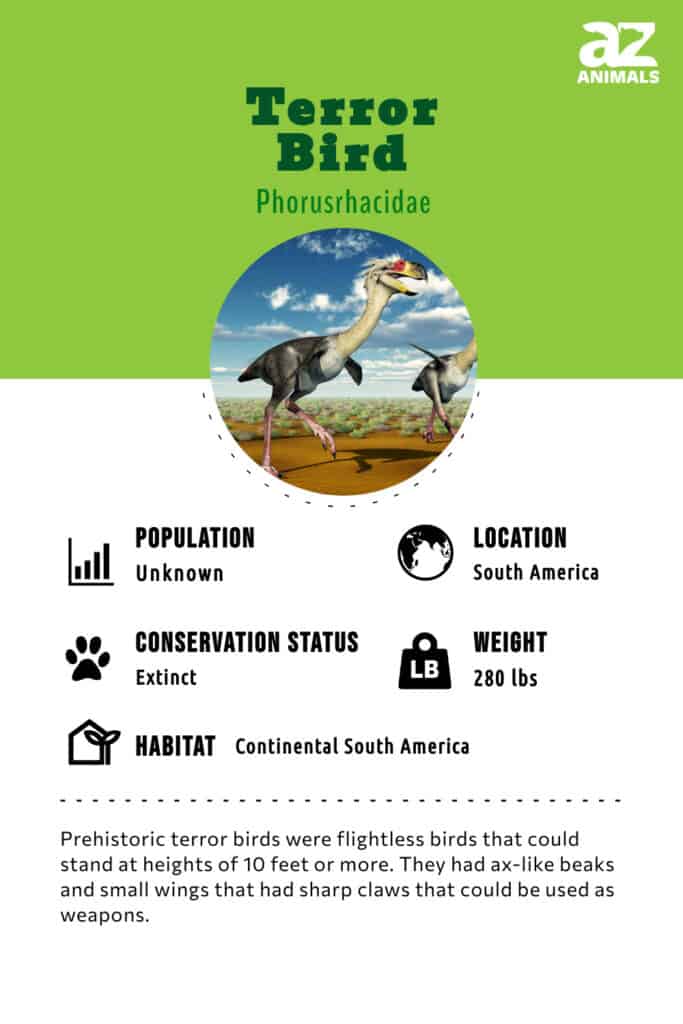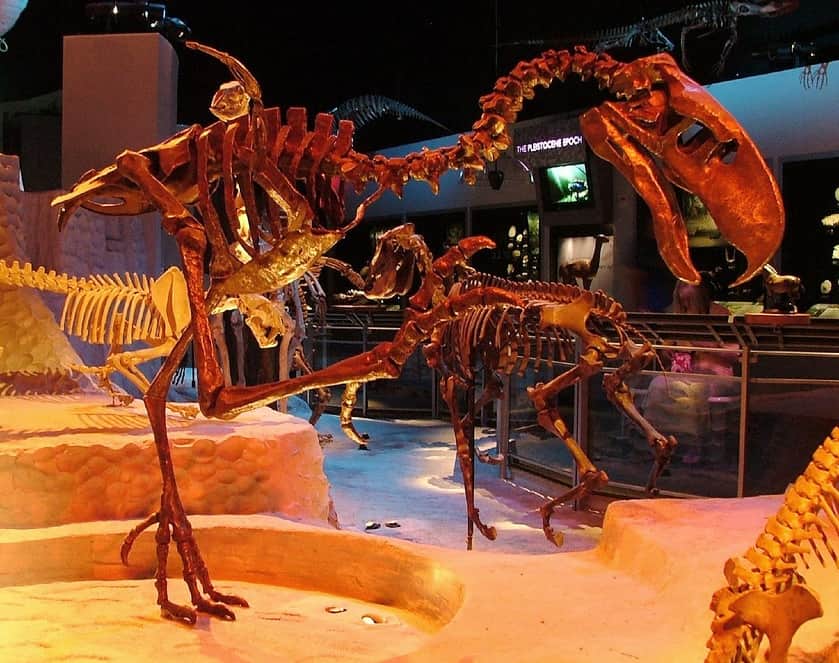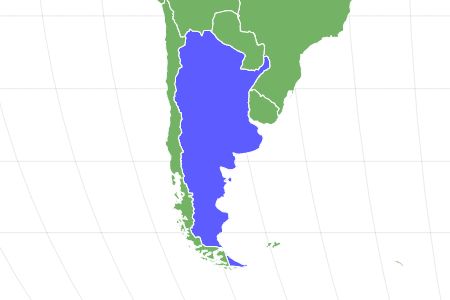Terror Bird
Though terror birds were flightless, their wings featured an unusual sharp claw which they could use as a weapon.
Advertisement
Terror Bird Scientific Classification
- Kingdom
- Animalia
Read our Complete Guide to Classification of Animals.
Terror Bird Conservation Status
Terror Bird Facts
- Main Prey
- Smaller animals
- Fun Fact
- Though terror birds were flightless, their wings featured an unusual sharp claw which they could use as a weapon.
- Biggest Threat
- carnivorous dogs, bears, and cats like the sabre-toothed tiger
- Most Distinctive Feature
- Ax-like beak similar to a modern-day bird of prey
View all of the Terror Bird images!
The aptly named Terror Bird was a feathered predator that ruled the forests and plains of South America shortly after the dinosaurs died out. The giant flightless bird was characterized by its large weapon-like beak that has been likened to a pick-ax. Despite its huge size, the terror bird was faster than a modern horse.

Description & Size
Phorusrhacos is the scientific name of this large genus of flightless birds. The name means “rag bearer” in Latin for some unknown reason. However, the name Terror Bird is more commonly used for this clade of monstrous carnivorous birds that ruled the South American ecosystem between 60 million and 2 million years ago.
Commonly considered the largest flightless bird of all time, the Phorusrhacos stood at over 3 meters (more than 10ft). It was no doubt one of the apex predators in its region and held that spot until other large predators like the Saber-Tooth Tiger moved to South America from the North.
Scientists estimate that the terror birds might have weighed about 130 kilograms (280 lbs.). Unlike modern flightless birds like the ostrich with relatively small heads and beaks, the terror bird’s head was quite large, and it had fearsome beaks that looked like that of modern birds of prey like the eagle.
The Phorusrhacos’ small wings made it impossible for the bird to fly. However, the wings had an unusually sharp claw that the bird could use as a weapon. But perhaps the most formidable weapon it had was the ax-like beak which could tear into prey and kill them instantly. The Phorusrhacos had long skinny legs that were adapted to running. Their thick-scaled feet had sharp talons for attacking prey. The bird’s immense stride length and large heart suggest that it could run faster than a horse at full speed.

Terror birds were feathered predators who were largely found in South America.
©Michael Rosskothen/Shutterstock.com
Diet – What Did Terror Birds Eat?
The deadly Terror Birds were apex predators during their time. Fossil evidence suggests that all Phorusrhacids were carnivorous. The downward curve at the tip of their powerful beaks is similar to that of modern-day birds of prey. Like many extant bird species with beaks like this, they most likely used their beak to tip flesh from prey.
Initially, scientists thought the Phorusrhacos could catch prey with its mouth and shake it from side to side. However, a close examination of this bird’s skull and neck muscles suggests that it would have been unable to do this. However, it could exert a significant downward force on prey animals. Scientists are also divided on the theory that the bird could have been a scavenger. They had a varied diet that consisted of any animal smaller than them.
Habitat – When and Where It Lived
The Early Miocene to Middle Pleistocene period was the peak of the Terror bird’s reign. This was about 20 million to roughly 1.8 million years ago. During this time, South America was an isolated continent, and the Phorusrhacos reigned supreme as the top predator for millions of years.
Many of their fossils have been discovered in the Santa Cruz Formation in the Santa Cruz province of Argentina. Grasslands, deserts, and steppes characterized the region at the time, and the terror birds most likely favored the grasslands and woodlands as the preferred habitat. Their range might have covered the Patagonia region on the Southernmost edge of South America, which now covers parts of present-day Argentina and Chile.
Threats And Predators

While the Sabre-Toothed
Tiger
probably couldn’t prey on terror birds, it may have outcompeted them for prey, thereby displacing them.
©Rom-diz, CC BY-SA 3.0, via Wikimedia Commons – License
For a long time, the Phorusrhacos were the biggest birds on the isolated South American continent. However, the emergence of the Isthmus of Panama (a land bridge connecting South and North America) 2.7 million years ago allowed the Sabre-Toothed tiger and other big predators to migrate to South America, tipping the power balance in the area.
Given the Terror bird’s size and ferocious appearance, it is unlikely that any of these new predators could prey on it. It could defend itself using its beak and claws. However, the invading species like the Smilodon were prolific hunters as well. They could have outcompeted Phorusrhacos and displaced it as the top predator.
Discoveries and Fossils – Where It was Found
Argentinian paleontologist Florentino discovered the first Phorusrhacos fossil in 1887. The first-known genus identified was the Phorusrhacos longissimus, and the description was based on a Jawbone fragment. Initially, the giant bird was thought to be a herbivorous mammal due to its massive size.
Later, in 1891, the discovery of other fossils confirmed that the initial discovery was a giant bird, not a mammal. Remains have been found in various localities in the Santa Cruz Province of Argentina. A more recent fossil discovery in Comallo, Argentina, revealed new information about the shape of the bird’s skull, confirming that it had a hooked rostrum that was more than half the length of the rest of the skull. The recent finding also showed that the bird was probably faster than initial estimates.
Evolution

Scientists think terror birds evolved 62 million years ago and were extinct about 2.5 million years ago.
©Amanda / CC BY 2.0 – License
It is believed that terror birds, of the family Phorusrhacidae, evolved 62 million years ago during the Paleogene period. They were part of a larger group of extinct species called cariamiformes, from which modern-day seriemas are descended. Scientists speculate that terror birds were related to a ground-dwelling bird that developed its large size and adaptations over time.
Extinction – When Did It Die Out?
The emergence of the Isthmus of Panama about 2.7 million years ago marked the beginning of the end for the Terror birds of South America. As part of the fauna interchange that followed, many ancient carnivorous cats, dogs, and bears crossed into South America. This increased competition for food between the phorusrhacids and the invading species. The phorusrhacids population declined sharply afterward, strengthening the theory that the newly arrived predators contributed to their disappearance. The Terror birds disappeared about 2.5 million years ago. The species went extinct along with other prominent predators native to South America like the Sparassodonts and the terrestrial Sebecid crocodilians.
Terror birds were also present in North America, such as the Titanis walleri, a genus of Phorusrhacidae. These birds were believed to have survived longer than those in South America by nearly a million years, facing extinction 1.8 million years ago.
Similar Animals to The Terror Bird
Similar ancient animals to the Terror birds include:
- Argentavis magnificens– this giant eagle-like bird ruled the South American Skies bout 6 million years ago and must have lived alongside the Terror birds. The Argentavis was the largest flying bird ever to exist.
- Sparassodonts- these were carnivorous mammals more closely related to present-day marsupials. These predators lived alongside the Terror birds but were not really a competition considering their smaller size.
- Titanis- this massive bird was similar in size to the Phorusrhacos. It went extinct during the Pleistocene epoch.
Terror Bird FAQs (Frequently Asked Questions)
Why did terror birds go extinct?
When did terror birds go extinct
Terror birds disappeared about 2.5 million years ago. Their extinction is not linked to any major world-wide extinction event.
Did the terror birds ever meet humans?
Recent research regarding the possibility of humans living alongside the giant terror birds confirmed that there were no way humans could have met the terror birds. The giant Titanis walleri, one of the last sets of terror birds, became extinct over 10,000 years ago.
What did terror birds eat?
Thank you for reading! Have some feedback for us? Contact the AZ Animals editorial team.
















